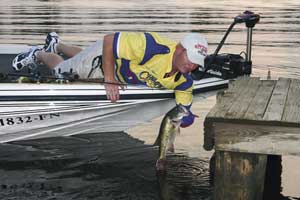
Marsh bass will cover the banks this month. Here’s how to get them on the end of your line.
Have you ever seen those guys on TV trying to catch a bedding bass during some big-money tournament? Man, they have it made. Crystal clear water, big shiny beds, hardly any wind … and then they prance around and kiss the fish or yell at the poor thing after they yank it over the side of their boat.
Put that clown in the middle of a Southeast Louisiana marsh, and see how much dancing he does. You can bet he won’t find that crystal clear water. He’ll definitely have trouble finding big old shiny beds. And the wind? Let’s just say he better keep his pucker in his pocket because he’ll have a hard time finding any fish to kiss.
But the old cliché that a bass is a bass no matter where it lives is no more true than it is in the marsh. Just because they live in brackish marsh doesn’t mean that they don’t have the urge to make babies. Marsh bass spawn too, and anglers who learn how to find and fish active beds just might do a little dancing of their own.
“There are a lot more variables to consider when trying to catch a bedding marsh bass than a bedding bass in a near pristine reservoir environment,” said Jason Pittman, a professional angler and Champion Pro Staffer living in Covington. “The neat thing, though, is that once you find a couple bedding fish in the marsh, they tend to be a little more aggressive than reservoir bass when it comes to removing an intruder.”
Ah, but there’s the rub — finding them. Everything else about the spawn in the marsh is the same as in a reservoir. They still have to wait for the right combination of water temperature and moon phase. They still have to fan out a bed on which to lay the eggs. And they still have to stand guard over those eggs until they hatch.
Once they’re found, though, they typically aren’t that difficult to catch.
Water temperature plays the most crucial role in determining when bass move in to spawn in the marsh. They tend to spawn anytime the water temperature is between 58 and 66 degrees, with the initial wave moving in once it hits 58.
“I’ve seen them move onto beds as early as late January and as late as late February,” said Pittman. “When they move in is a seasonal thing, and it can be different each year depending on the number of cold fronts moving through Southeast Louisiana. The best time to find bedding bass is any time from February through April.”
The rest of this story, which first appeared in the March 2007 issue of Louisiana Sportsman, can be read in our online archives.
And don’t forget that digital copies of the magazine also can be purchased online.
